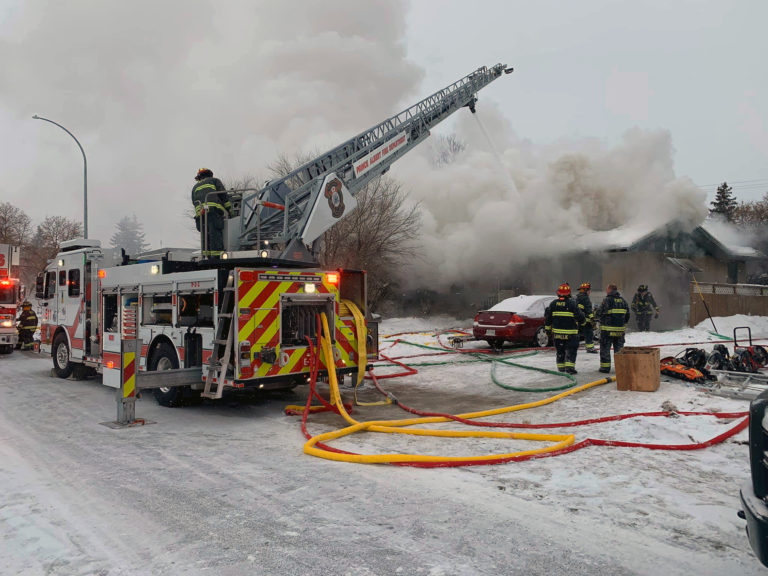
Mayor Greg Dionne said the City of Prince Albert definitely needs two new fire halls, but construction likely won’t start until 2023 at the earliest.
Dionne’s remarks came following a recommendation from the Prince Albert Fire Fighters Association, who say it’s taking too long to respond to fires in the southeast corner of the City.
“In five or 10 years, it’s feasible,” Dionne said after Monday’s executive committee meeting. “We know we’re going to expand further west on the hill, so we should find a spot and put a sign there that says it will be considered (as a possible fire hall site) in the 2023 budget. Then people will know we’ve decided, but today, financially, today, we cannot do it.”
Dionne said he expects each new fire hall to cost around $4-million, but that isn’t the main issue. The City can’t afford to operate three fire halls at the same time, even though equipment from the current fire hall would be spread around the two new ones. The Fire Fighters Association has recommended turning the current fire hall into a training centre that would house offices for fire inspectors and management.
The City may also have to hire additional fire fighters to operate out of the new buildings. The association said it can make due with nine firefighters a shift spread out over the two fire halls, but would prefer to see that number increased to 12.
They also want to see the fire halls built before the new hockey rinks and recreation facilities are built in the southeast corner of Prince Albert, something Dionne said is unlikely because the City doesn’t have the money.
“I can assure you that will not happen,” he said. “That’s why we decided to make that project into three phases. We can afford phase one today, which we got $44-million for, and our $16-million plus the $6-million for the land, so we’re proceeding with that.”
The rest of Prince Albert city council echoed those concerns. They voted unanimously to send the item to budget deliberations this fall, but believed the City needed a payment plan before going any further.
“It’s fine to say we’re supportive of it, but that’s the easy part,” said Ward 8 Coun. Ted Zurakowski, who represents the West Hill area, which has seen significant development over the past several years. “How are we going to pay for it? Let’s have that conversation. But, I’d also say we need to move forward and identify those two (new) locations so that we can plan for them, knowing that those two pieces of land are locked in.”
Fire Fighters Association president Jeff Reeder said there were two potential locations identified during a GIS survey conducted 12 years ago. The first is near 10th Avenue and 28th Street West, which would place it near the Alfred Jenkins Field House. The second was along 15th Avenue and 22nd Street East, near École Holy Cross.
However, Reeder said they’re willing to be flexible about the new locations.
“We need to have it setup geographically so we can maintain that five minute and 20 second response time, so it’s however we can best accomplish that goal,” he explained in an interview after the meeting. “We’re not too picky on the location, as long as we get our response time (down).
The five minute and 20 second response time was adopted in 2001 after 10 years of research by the National Fire Protection Association. Those guidelines govern fire departments in both Canada and the United States.
Currently, the Prince Albert Fire Department takes anywhere from seven to 12 minutes to get to the southeast corner.
Reeder said that problem is only going to grow, since newly built houses often burn quicker than their older counterparts. Homes built in the ‘70s or ‘80s can reach flashover temperatures—where the entire room ignites—within five to seven minutes. He also said the new indoor aquatic and arenas complex makes it even more important that first responders can get to that area of the city quickly.
“My thinking would be to have two fire halls built before the hockey arena complex. That’s another added (asset) that needs to be protected adequately,” Reeder explained. “You’re talking three four years, you can set aside land, a couple of years of budget cycles, and have the goal within three to four years to have those stations built.”
He added that the department was prepared to work with nine fire fighters spread over the two fire halls, but said using 12 would increase safety, and provide a better fire response, since they won’t enter a building until at least four fire fighters are on scene. The typical house fire requires around 15.
“Our current staffing model is basically designed for homes that are built in the ‘70s,” he explained. “We’re currently not meeting that at all.”
